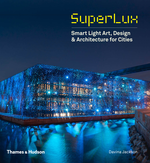
There is arguably no aspect of architecture in which science is more influential than in the realm of lighting; from the florescent bulbs of the late 19th century to the LEDs that only became truly viable in the past decade or two, advances in the science of creating light have been quickly followed by architectural experimentation. In this excerpt from her book "Superlux: Smart Light Art, Design & Architecture for Cities," Davina Jackson recounts the tremendous advances made by lighting in the 20th and early 21st centuries, and looks forward to the next frontier - that of "smart lighting."
Today’s smartest lighting innovation has no need for machine-generated power. Simply fill a clear plastic bottle with water (plus bleach) and silicon-seal it through a hole in the roof of any rudimentary shelter. Behold: daylight floods the dark interior.
PET bottles for conducting radiance, solar-powered LED lamps for night visibility and satellite-enabled smartphones to exchange instant knowledge globally: these are the 21st century’s keys to illuminating billions of people living rough in settlements. Like the original campsites of London, New York, São Paulo and Sydney, some of these slums will become great global centers.

Light is the universal source of all human potential to act (even to eat) and achieve. After millennia of human reliance on flames, Thomas Edison demonstrated the first commercially viable electric lamp in 1887. He switched on the modern era of relentlessly radiant cities, beginning with the Eiffel Tower in 1889 and underpinning the utopian mid-20th-century visions of Le Corbusier, Mies van der Rohe with Richard Kelly, and other visionary urbanists on both sides of the Atlantic.
Flying over high-rise New York during the pre-1960 years of electricity-enabled commercial air travel, American atomic physicist Nick Holonyak, Jr. (then a young researcher for General Electric, the company Edison founded) told himself there must be a smarter way to light cities. He knew that incandescent lamps convert only 10% of their electrical supply to light and the other 90% is lost to heat.

"RED HOT" was the coverline of science journal IEEE Spectrum when it featured Holonyak’s 1962 demonstration of the first visible red laser beam, which he generated from a pill-like semiconductor that was later labelled ‘the magic one’. This white disc, incorporating tiny cleaved mirrors, was the world’s first effective light-emitting diode (LED). It was made from its inventor’s own alloy of gallium arsenide phosphide (abbreviated to GaAsP in science’s periodic table of elements).
Holonyak’s momentous creation of that first viable LED was followed by LEDs in yellow and green, before Japanese inventor Shuji Nakamura, working for Nichia Corporation, demonstrated the first high-intensity blue LED in 1994, and then proved that coating blue LEDs with a yellowish (YAG) phosphor could generate high-intensity white light. Nakamura and collaborators Isamu Akasaki and Hiroshi Amano won the Nobel Prize for Physics in 2014.

Holonyak’s invention triggered the late 20th century’s vast revolution in electronic equipment, including today’s networked tablets and mobile phones. Nakamura not only enabled the current Blu-Ray DVD units and many ambitious RGB light and video spectacles in public venues, but also, crucially, created the LED non-colours (warm or cool white) that are essential for everyday lighting of contemporary spaces.
Holonyak and Nakamura consecutively pioneered today’s global revolution in solid state lighting (SSL), where, in Holonyak’s words, "the current itself is the light." After many years of refinement by major lighting manufacturers, LED lamps now use up to 75% less energy and last up to 25 times longer than incandescent or halogen bulbs, and up to three times longer than compact fluorescent light (CFL) tubes. Further efficiencies are possible when LED lights are powered with energy from renewable sources, including solar, wind and biofuel systems.

The new frontier for eco-efficient light in cities is the smart grid, which allows power to be shared among users on local neighborhood networks – a strategy likely to minimize wastage of electricity over the longer distances necessary with metropolitan systems.
Another important goal is to reduce light pollution of the skies above cities. Is it a vain hope that parents might once again point their children to see stars from urban locations? The most promising strategy is to install new networks of dimmable LED streetlights and new fixtures designed to block uplighting and spread beams downwards.
We also need to find alternatives to carbon-belching fireworks and photon-spraying sky lasers for celebrating public occasions. Two internationally applauded events launched in Sydney – the "Earth Hour" switch-off-lights demonstration in 2007 and the "Smart Light Sydney" exhibition of non-carbon light artworks in 2009 – were international milestones highlighting new, ecologically responsible agendas among younger generations of cultural leaders.

Thanks to Holonyak and his followers over the past half-century, we now revel in a third age of light: the digitally networked LED era of cool-to-touch electroluminescence. Their advances in atom-related physics sparked unprecedented creative potentials for the internet-era "City of Bits" heralded in 1995 by MIT architecture scholar, William J. Mitchell. Professor Mitchell also propagated the term "smart cities," which inspired our choices here of "smart light" projects.
This book is the world’s first comprehensively illustrated monograph surveying contemporary landmarks and outstanding creativity in the emerging movement of smart (electroluminescent) light for urban art, architecture and environments. It contains more than 400 images of post-2008 examples of energy-effective light installations: illuminated buildings, bridges, streets, parks, plazas, media walls, public interiors, gallery spaces and water systems, including interactions and augmented reality games using mobile devices. Also included is an illustrated timeline of historical achievements with luminous structures, including paint, perforations, projections and pixel screens. Finally we compare night-lit maps of cities, using photographs taken by European astronauts (notably André Kuipers), optimized with the International Space Station’s Nightpod (orbit speed focus correction) equipment.

Our essayists – Mary-Anne Kyriakou, Vesna Petresin, Thomas Schielke and Peter Weibel – provide uniquely informed perspectives on today’s converging conditions. To conclude, urbanism expert Peter Droege challenges us, extravagant exploiters of light, to accelerate 100% reliance on renewable sources of power.


